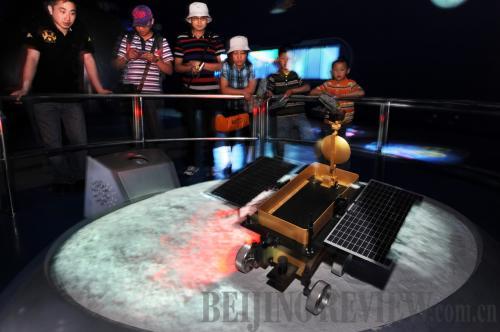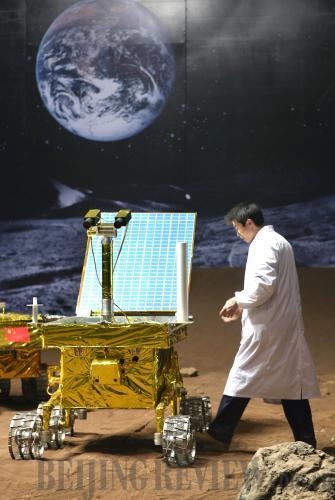A nifty gold-colored vehicle equipped with two solar panel wings attracted the attention of many visitors to the Space Pavilion at the World Expo site in Shanghai. It was the model of the lunar rover for China 's moon probe program.
Thousands of years ago, ancient Chinese people boldly imagined living on the Moon. Now the country's scientists have designed their own lunar rovers, and plan to land one on the Moon in 2013.
"In the past, we could only observe the Moon; with a lunar rover, we can touch the Moon," said Hu Zhenyu, a researcher with the Shanghai Aerospace System Engineering Institute.
China's lunar probe program, also known as the Chang'e Program, kicked off years ago.
The first spacecraft in the program, an unmanned lunar orbiter named Chang'e 1, was launched in October 2007. The second unmanned moon orbiter, Chang'e 2, will be launched at the end of this year.
 |
| EYE-CATCHING: A lunar rover model designed by Chinese scientists is exhibited at the Space Pavilion at the World Expo site in Shanghai (LI ZIHENG) |
Chang'e 2 is to prepare for the landing of the lunar rover, including selecting an appropriate landing site, said Ouyang Ziyuan, chief scientist of China 's lunar exploration program and an academician in Chinese Academy of Sciences (CAS).
Then the lunar rover carried by Chang'e 3 will land on the Moon. Its mission is to explore landscape, geological structure, minerals and chemical components of the Moon and to collect samples.
A lunar rover uses many of the world's most advanced technologies, including deep space communications, remote survey and control, moon-landing orbit design, soft landing technologies and the research and development of the moon probing robot.
Yang Junhua, Deputy Director of the Chinese Society of Astronautics, said many research institutes and universities in China participated in designing and developing lunar rovers, including the No. 5 Institute of the China Aerospace Science and Technology Corporation and Beijing University of Aeronautics and Astronautics. Each of them focused on one area. So far, about a dozen lunar rovers have been built.
The exact appearance of the lunar rover which will land on the Moon remains a mystery to the general public. Ye Peijian, Commander in Chief of the Chang'e Program and also an academician of the CAS, said it would look like the four lunar rover prototypes exhibited at the ninth China Hi-Tech Fair held in Shenzhen in 2007.
It would be light, agile, and adept at climbing slopes and steering away from obstacles, Ye said. Each wheel will have its own drive, and can adjust its height.
As the Moon's environment differs strikingly from the Earth, the lunar rover will face many challenges. It will work in a low-gravity vacuum, exposed to strong radiation and both extremely low and high temperatures. To protect the equipment from strong radiation, the lunar rover will be coated with gold.
The Moon's terrain is rugged and covered with craters of various sizes. More than 30,000 of them on the side of the Moon facing the Earth measure more than 1 km in diameter. Rocky outcrops are also scattered here and there, so the rover must have a reliable navigation system, said Zhou Kegang, Director of the Institute of Science and Technology of Hunan University, whose researchers took part in designing the rover.
"The rover is to be equipped with many electronic eyes cameras with 360-degree lenses. These powerful lenses will prevent 'traffic accidents' on the Moon", Zhou said.
There is no global dipolar magnetic field on the Moon, rendering compasses and GPS systems useless. The lunar rover could easily lose its direction, said Liu Jilin, a professor with the Information and Communication Engineering Institute of Zhejiang University.
"The computers will analyze the images collected by the cameras, and calculate the solar altitudes to locate the rover's position," he said.
Data collected by the cameras will be processed and reconstructed into a relief map in the rover's "mind", and steer it away from obstacles.
 |
| BREAKTHROUGH: A lunar rover model designed by Chinese scientists debuts on April 23, 2008, in a laboratory in Shanghai with simulated environment of the Moon's surface (LIU YING) |
Soil on the Moon also poses a challenge. "The Moon's surface is blanketed with a large quantity of fine particles, and some have static charge. The dust can be as thick as 5 to 6 meters. Dust can enter the rover or even cover the equipment, making it work less efficiently and less accurately," said Chen Zonghai, a professor of the University of Science and Technology of China.
The Moon's gravity is only one sixth that of the Earth's, which means the friction coefficient is low, and the lunar rover may slide easily, Chen said.
To find solutions to the problem, scientists experiment in a simulated lunar environment. The Moon's soil was simulated with materials such as volcanic ash. Scientists also simulated extremely high and low temperatures on the Moon, its gravity, terrain and other aspects of its environment.
To choose the best landing site, the satellite carrying the lunar rover will contain a "laser eye," a high-precision laser distance measuring instrument. The Chang'e 2 satellite will provide high-resolution photo images of the prospective landing area for the Chang'e 3.
As the Moon has no atmosphere, its surface temperature is determined by the amount of sunlight it receives. During the night or in shaded areas, temperatures can drop to as low as minus 150 or even minus 180 degrees centigrade. When the sun rises, it quickly heats the surface to more than 100 degrees centigrade. The rover must be able to endure temperature difference ranging from minus to plus 150 degrees centigrade.
Gasoline engines cannot be used to power the rover as there is no air on the Moon. "Usually, land rovers are powered by solar energy and by batteries," Zhou said. Solar panels on both sides of the rover capture solar energy during the day. At night, the panels fold up and cover the body of the rover to shield the equipment from extreme cold, and the vehicle will be powered by energy stored in its batteries.
One night on the Moon is equivalent to 14 days on the Earth, Zhou said. So for about two weeks, the rover will not be able to collect solar energy. In extremely cold, long nights, the rover will "hibernate," waking up at sunrise the next day and resuming working.
The lunar rover will carry lithium batteries or nuclear batteries which are small but powerful, Chen said. One of these batteries, measuring 18 cubic millimeters and weighing 160 grams, can store as much energy as a normal chemical battery weighing as much as an adult.
The lunar rover will also be the most intelligent robot ever made in China, said Ouyang. It can select its own routes, work with mechanical arms and send data back to the Earth.
The rover's "arms and legs" are highly intelligent and probe as the vehicle proceeds. The bottom of the rover carries radar equipment which can "see" several kilometers under the Moon's surface. It is also equipped with seven sets of apparatus, including an astronomical telescope which will enable the first astronomical observations made by a rover on the Moon. (Beijing Review)





